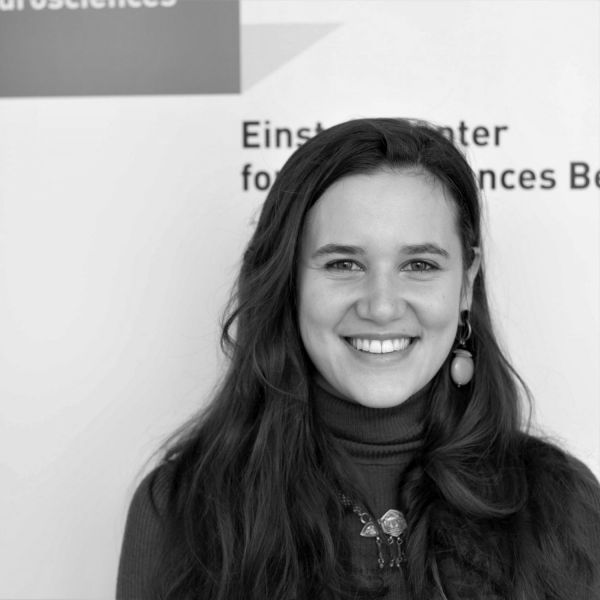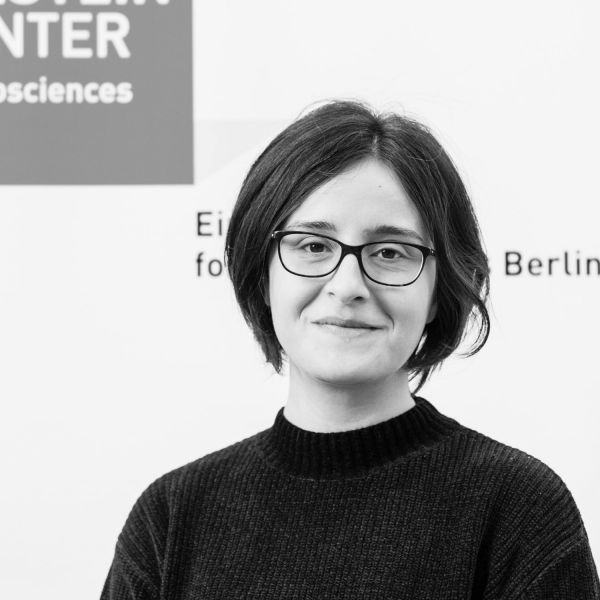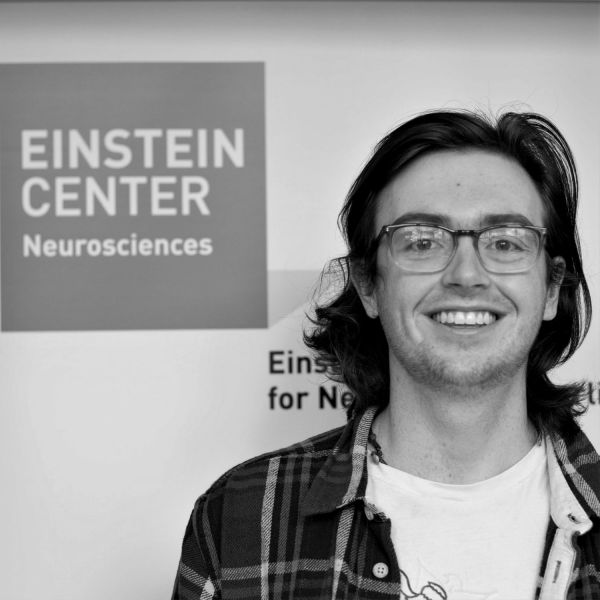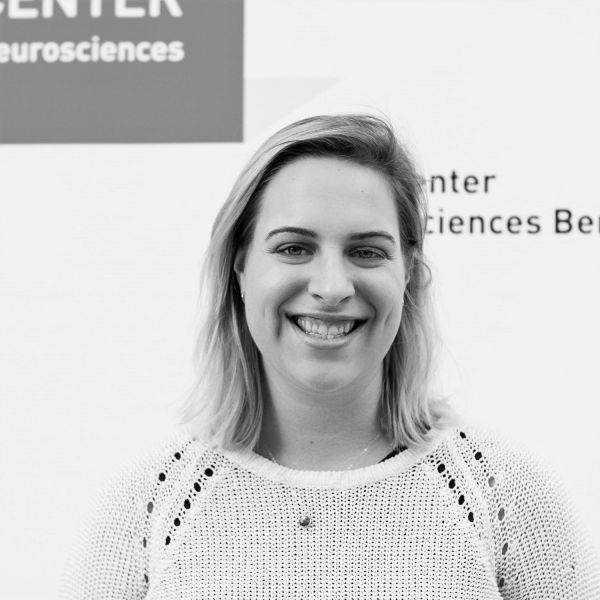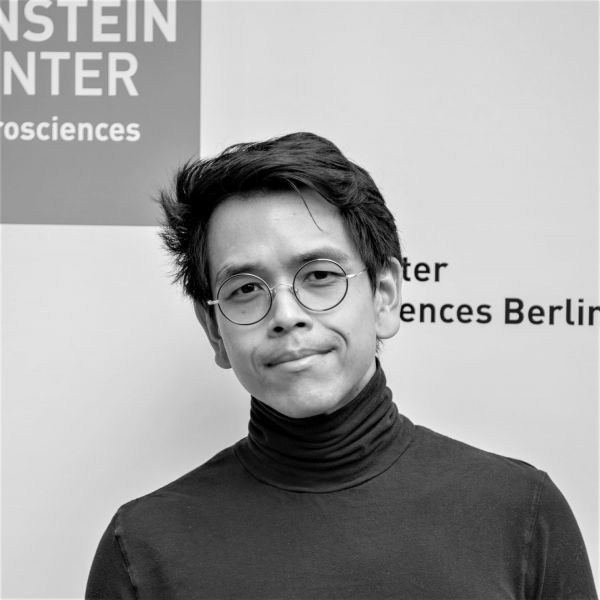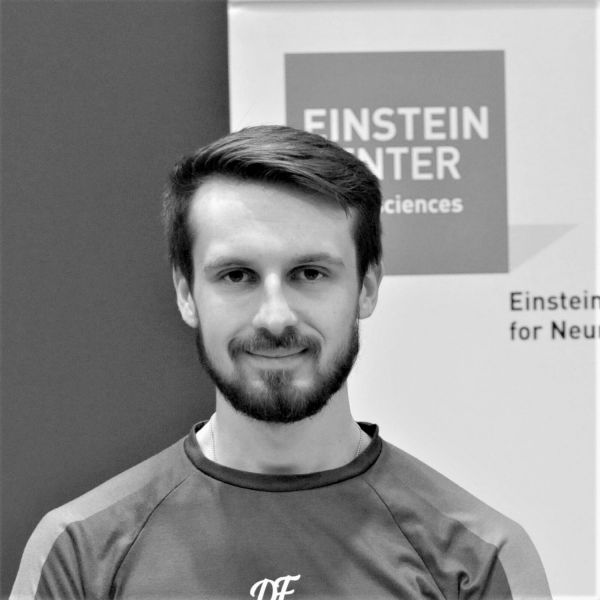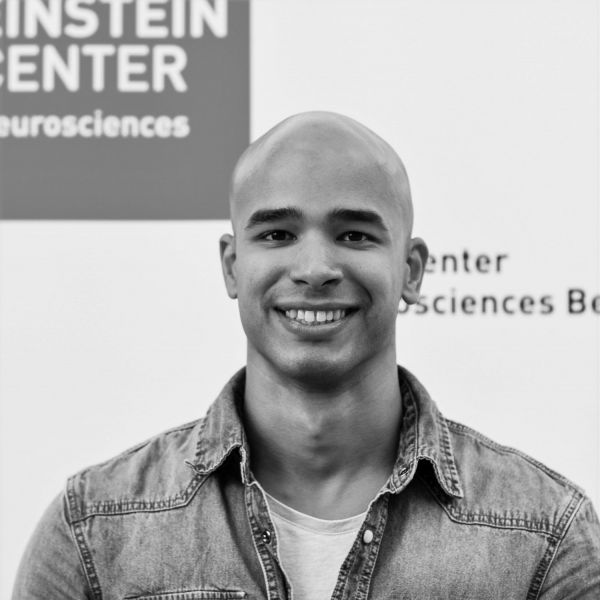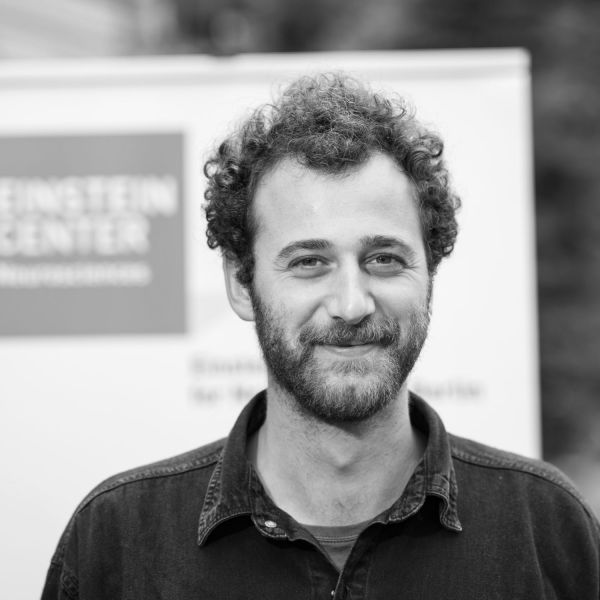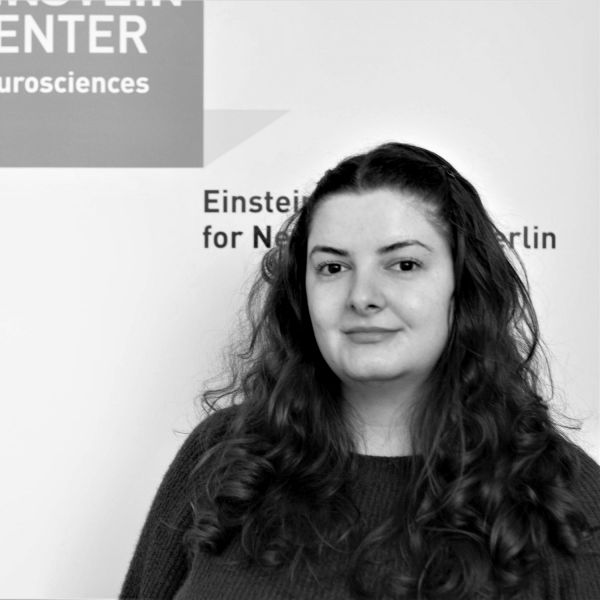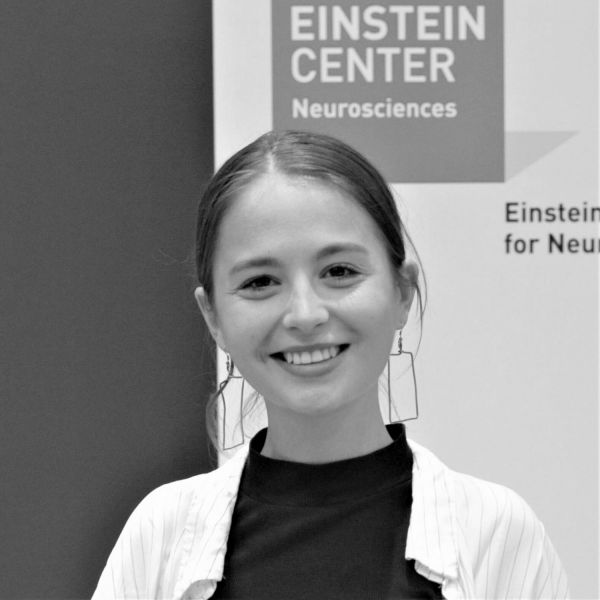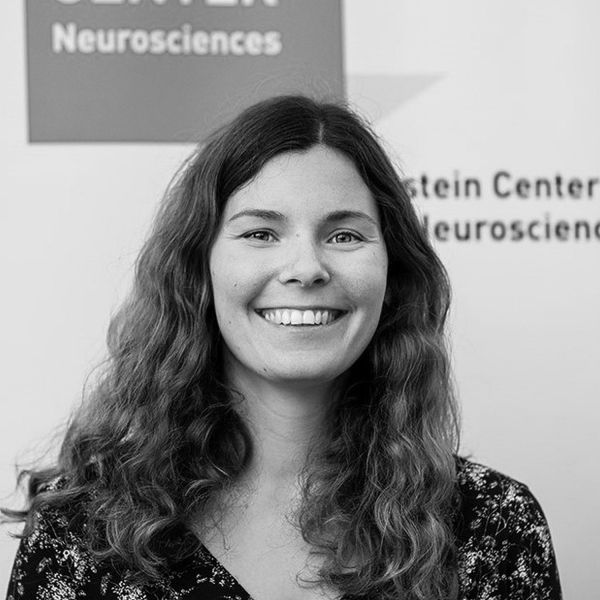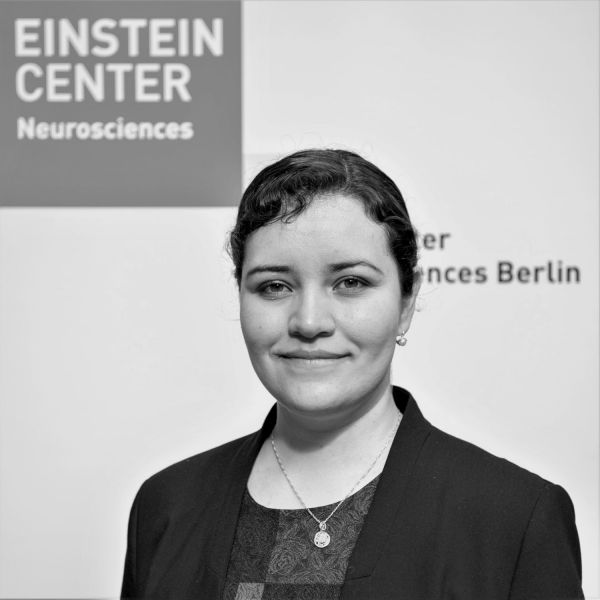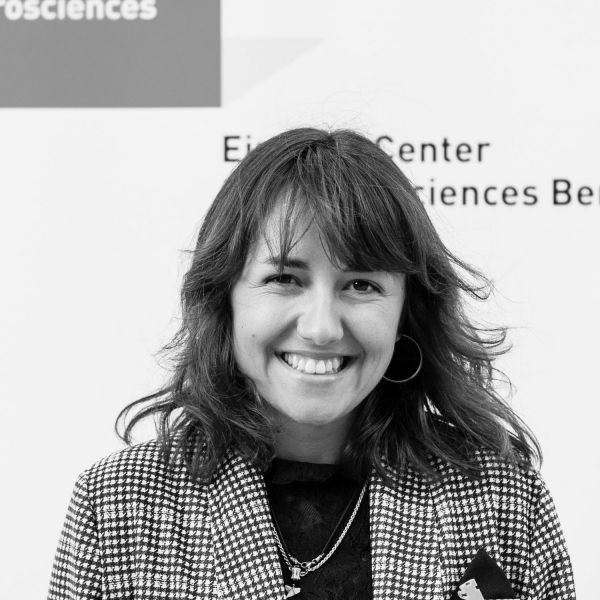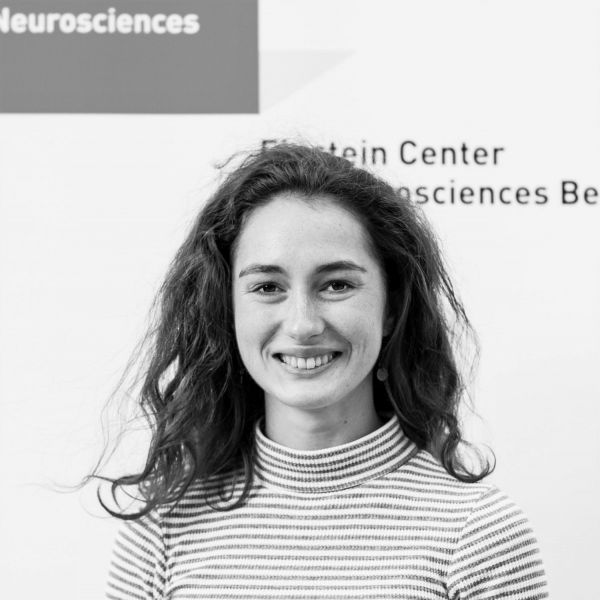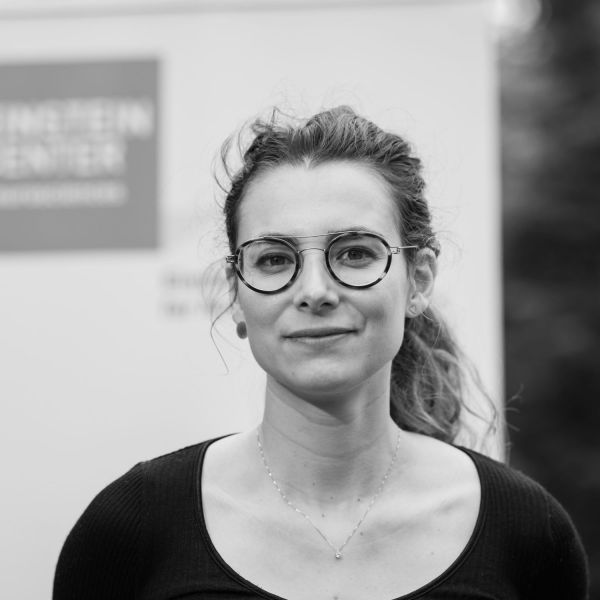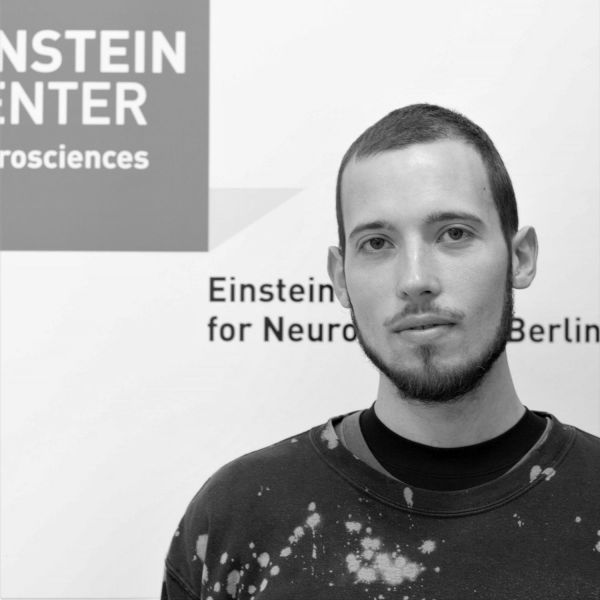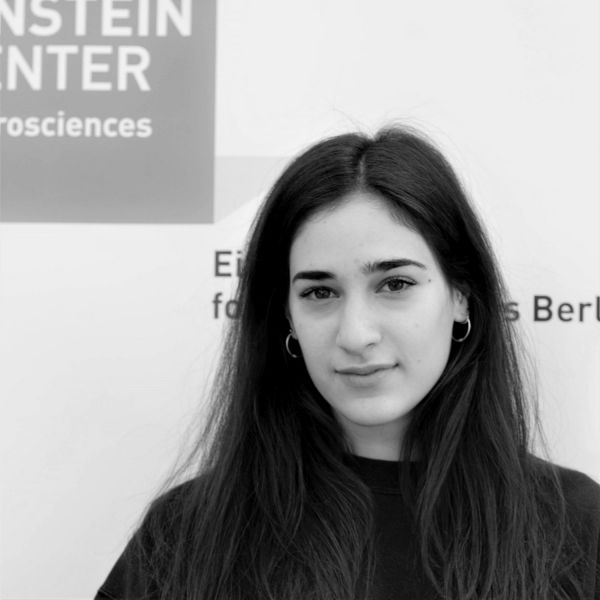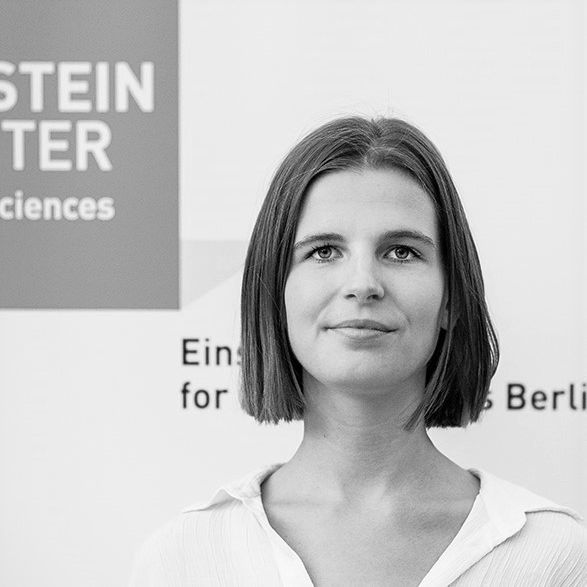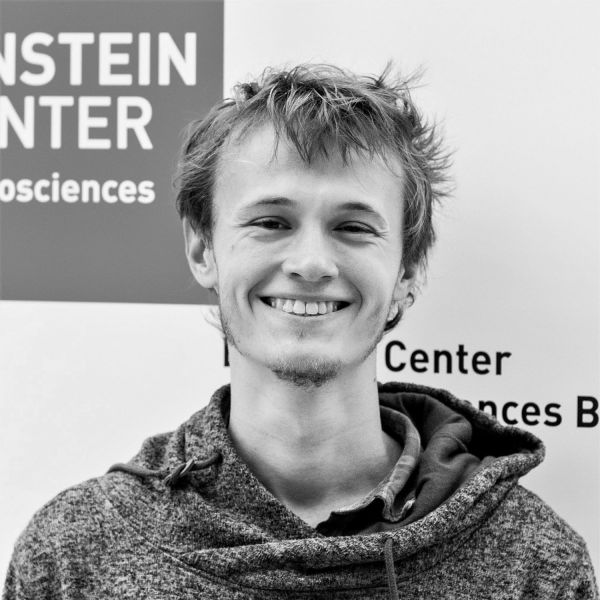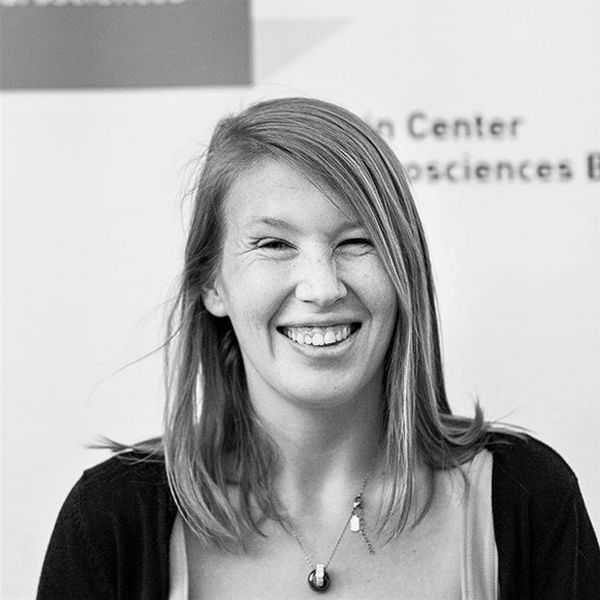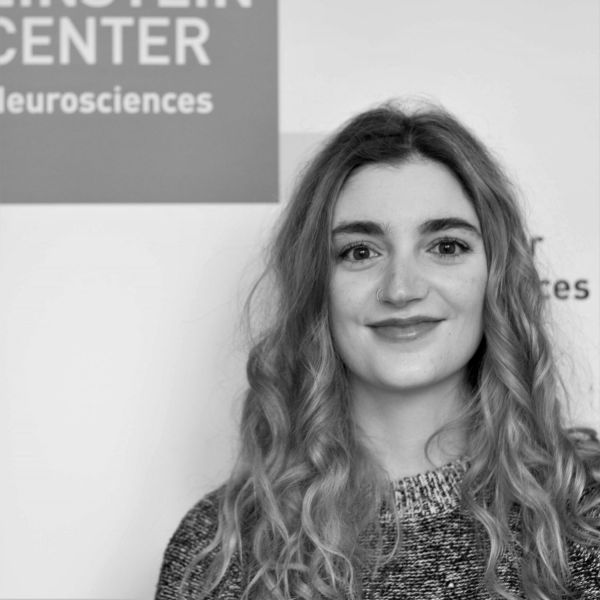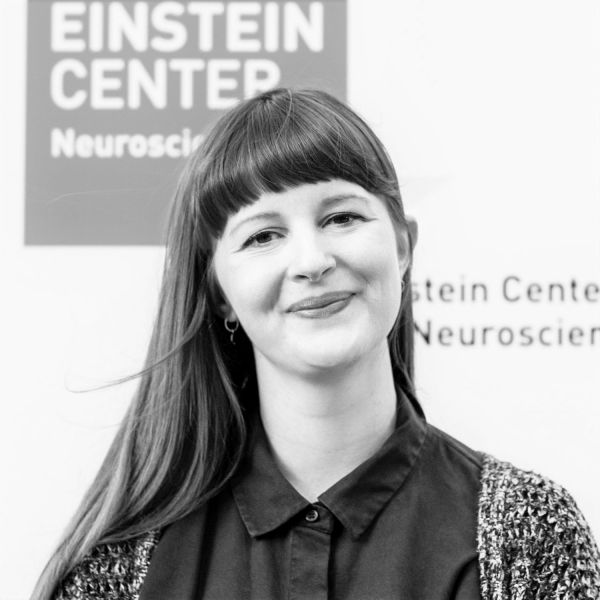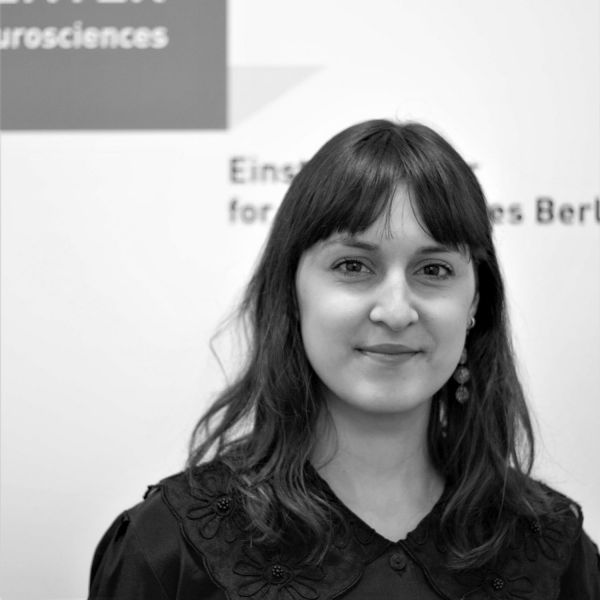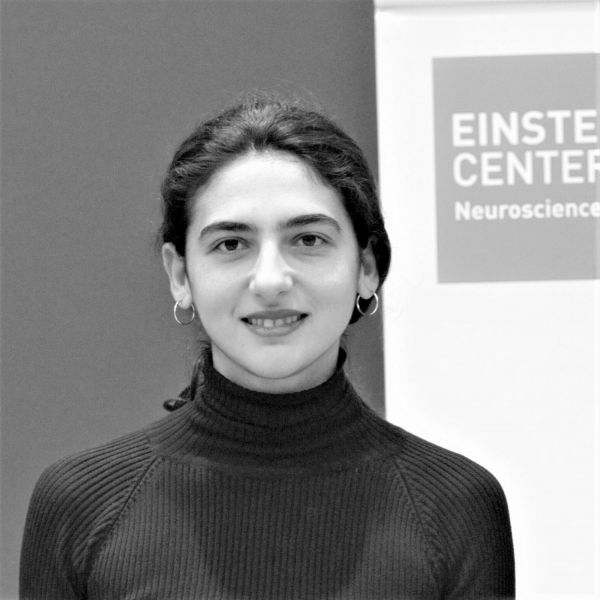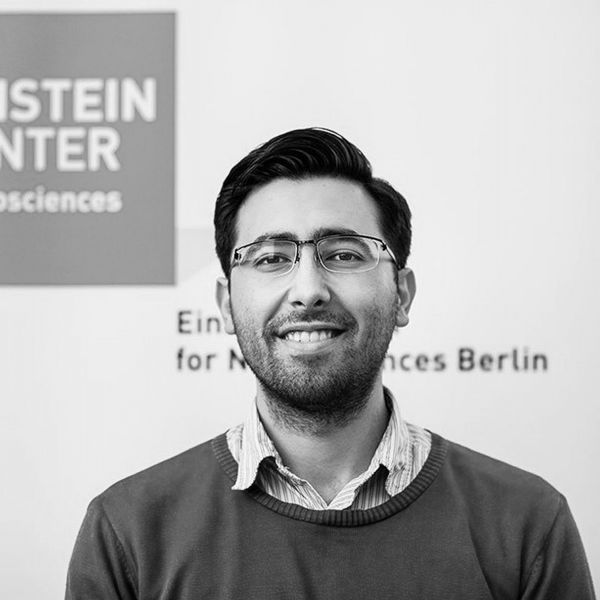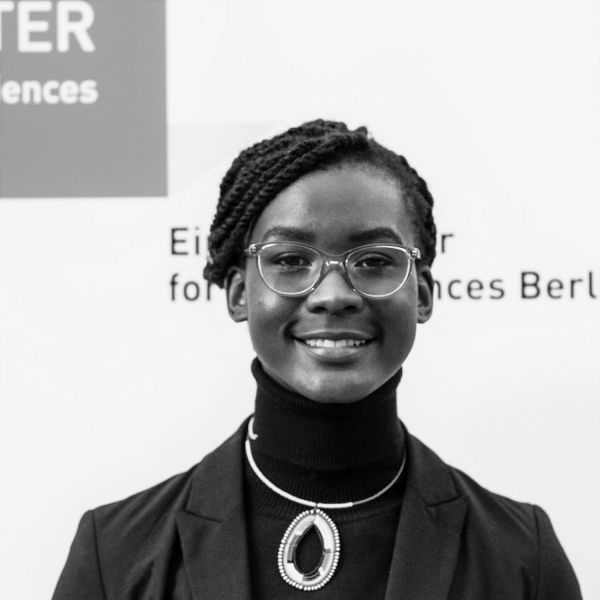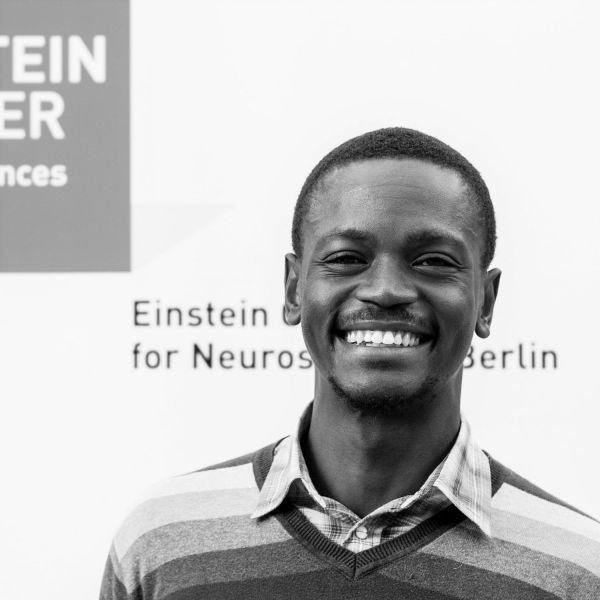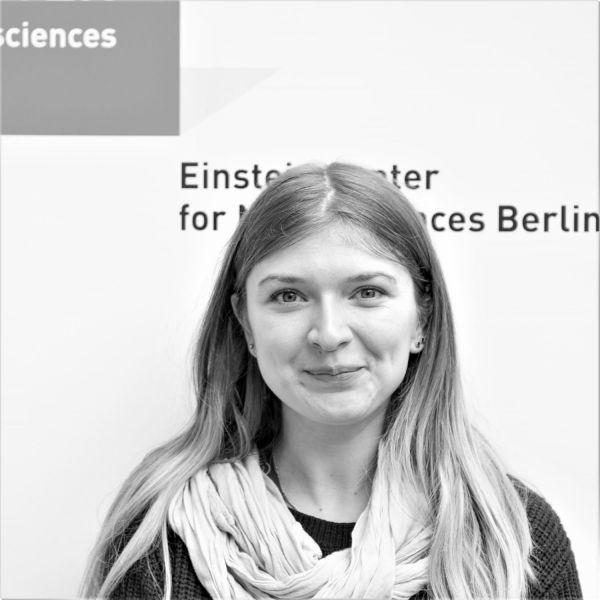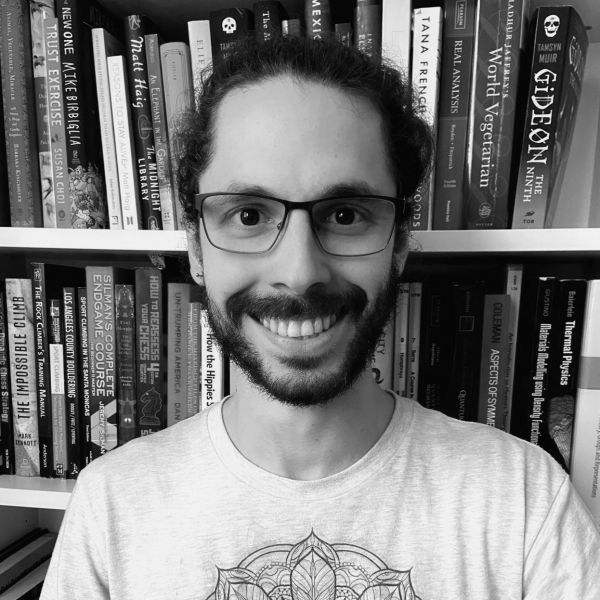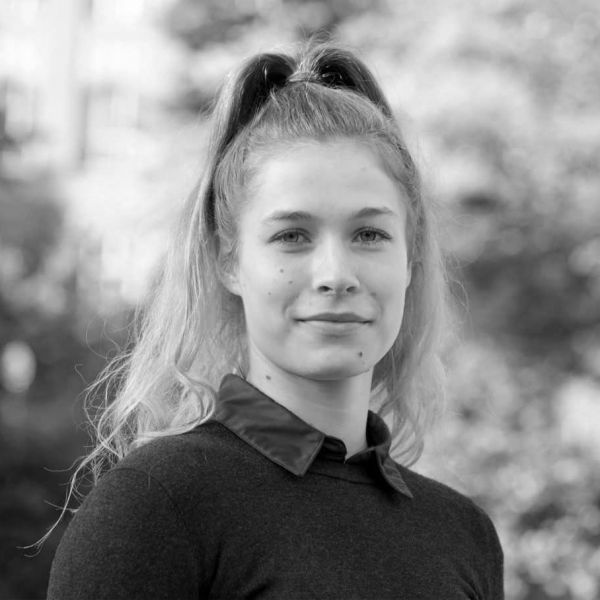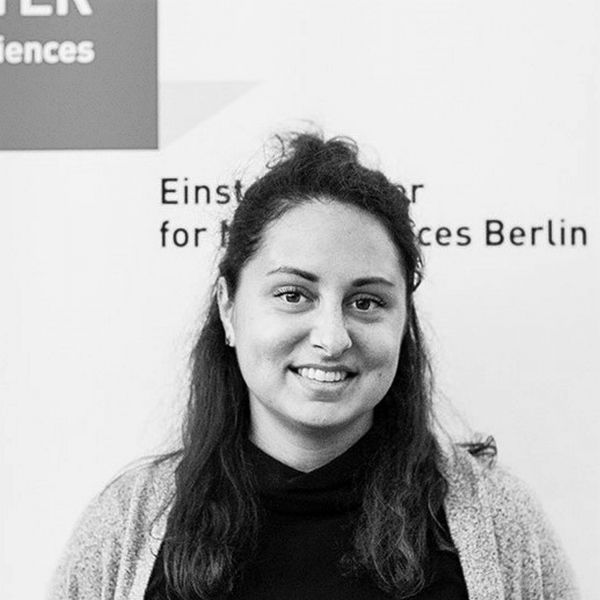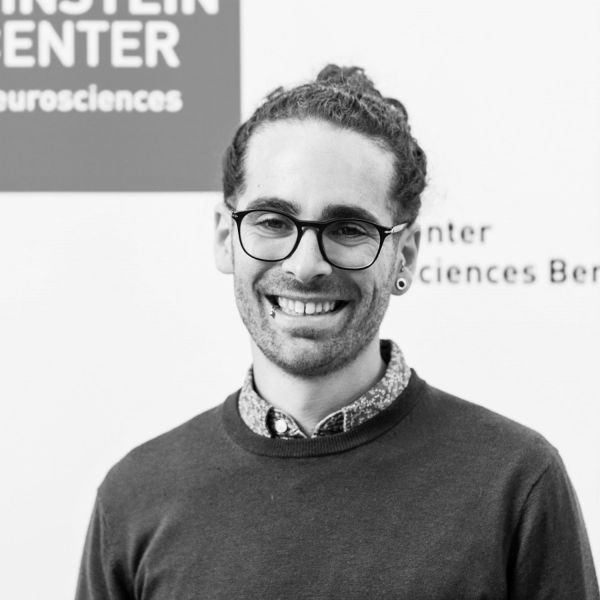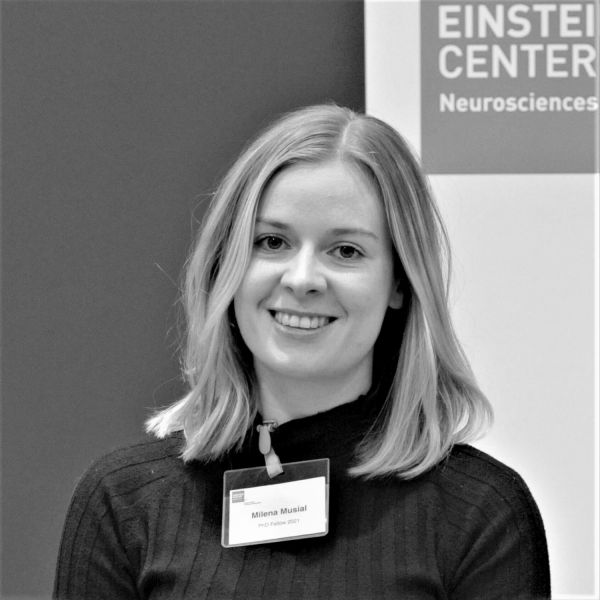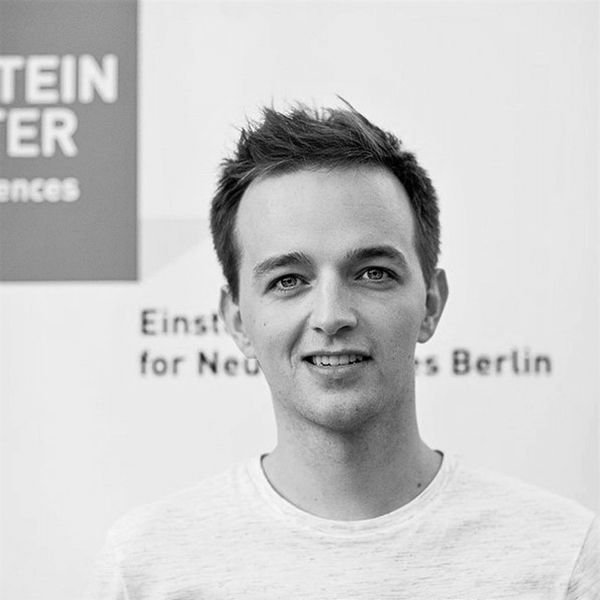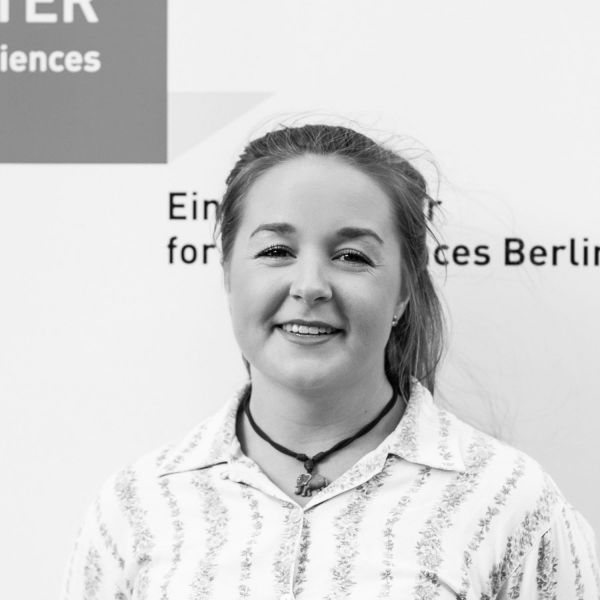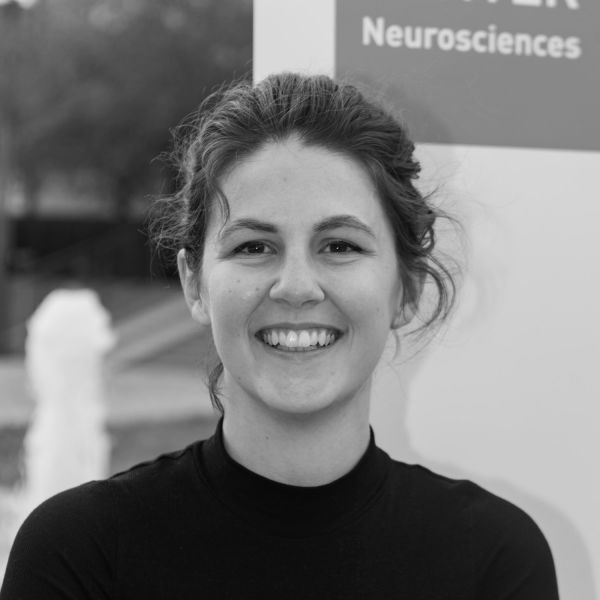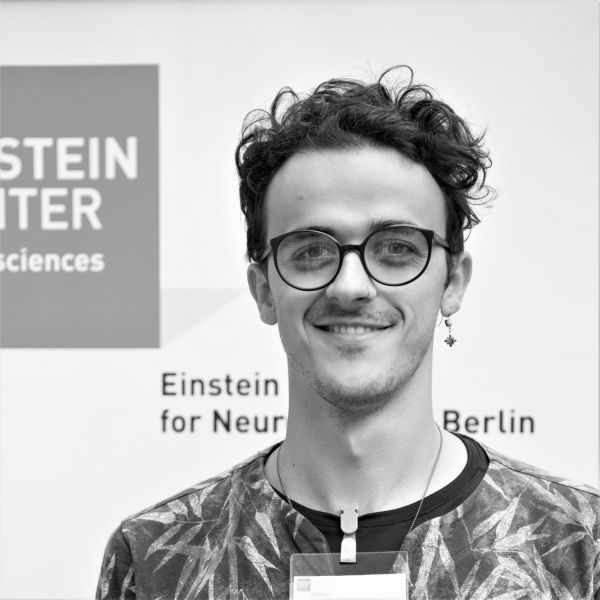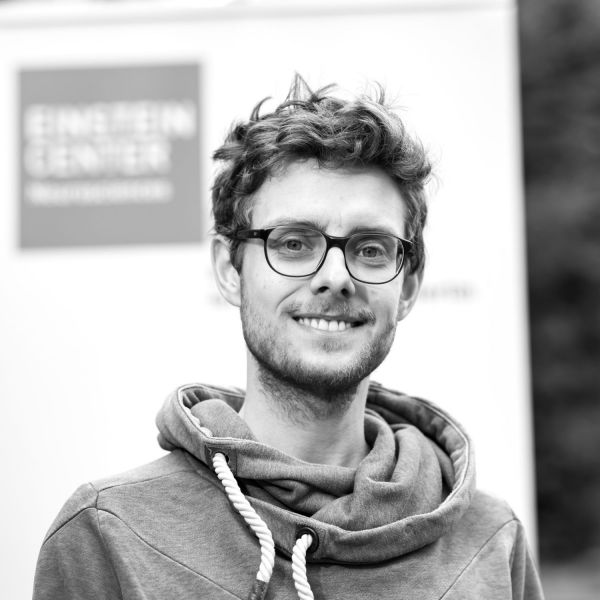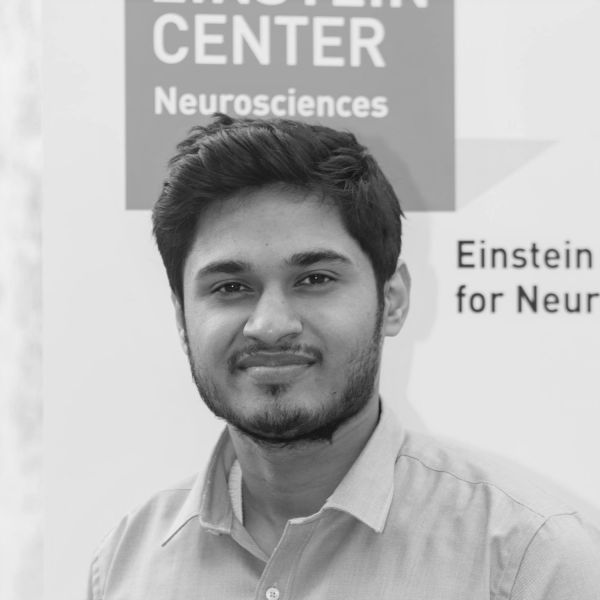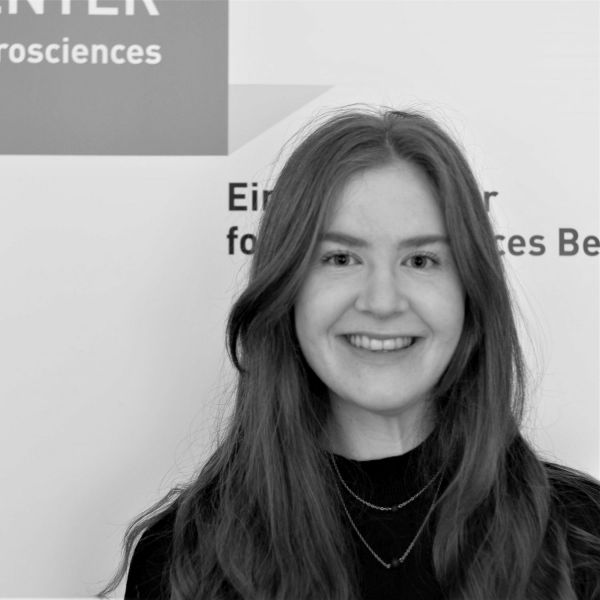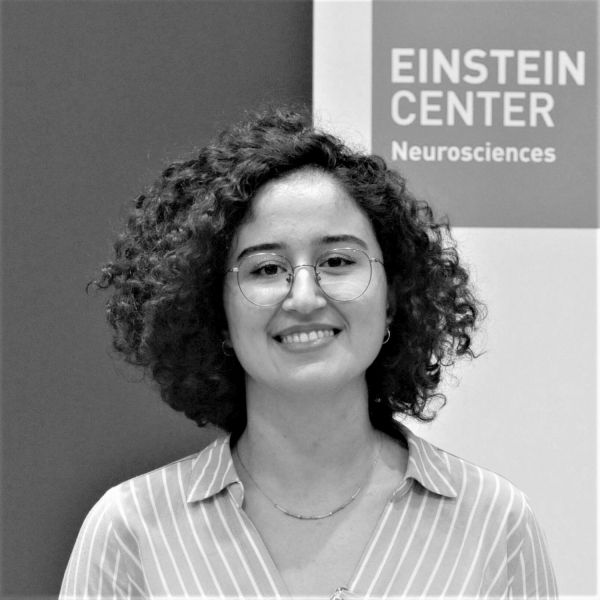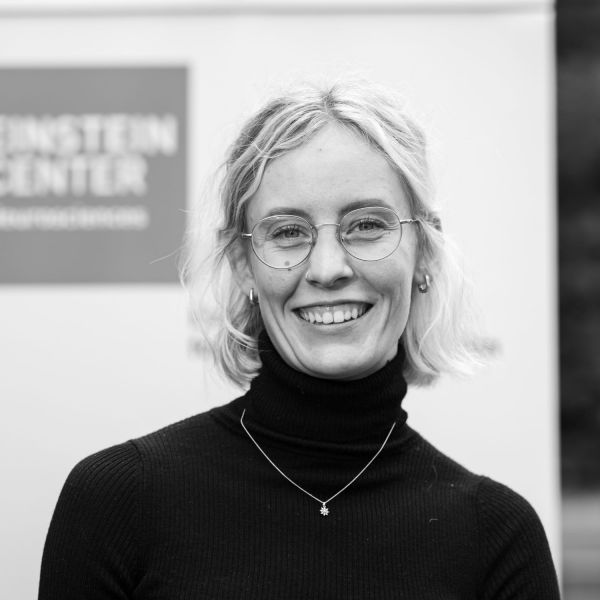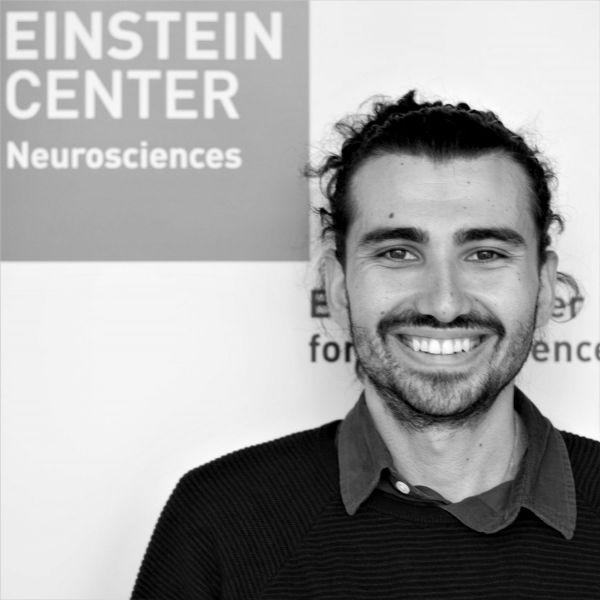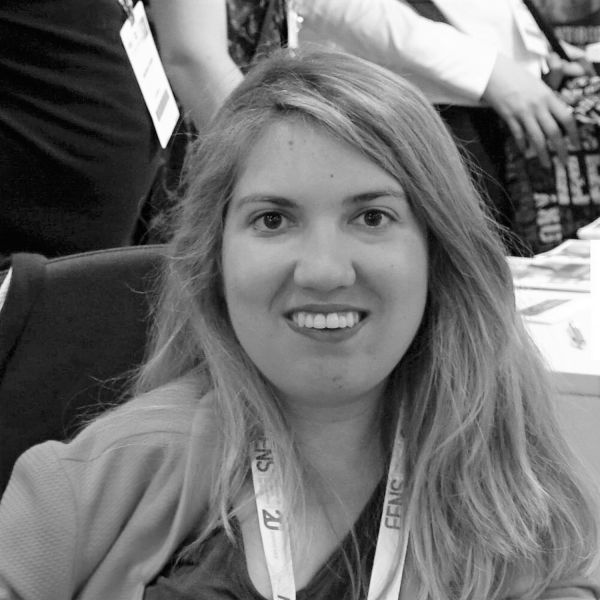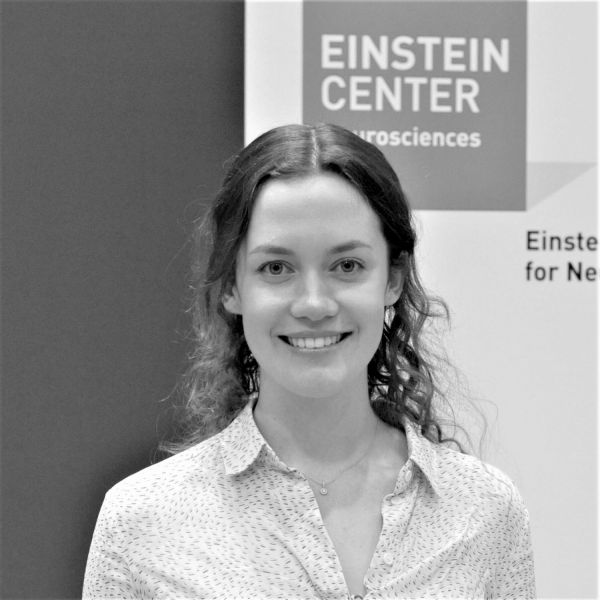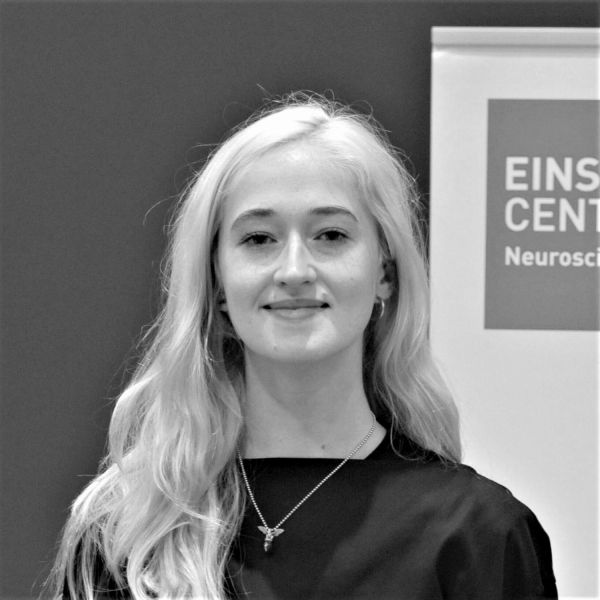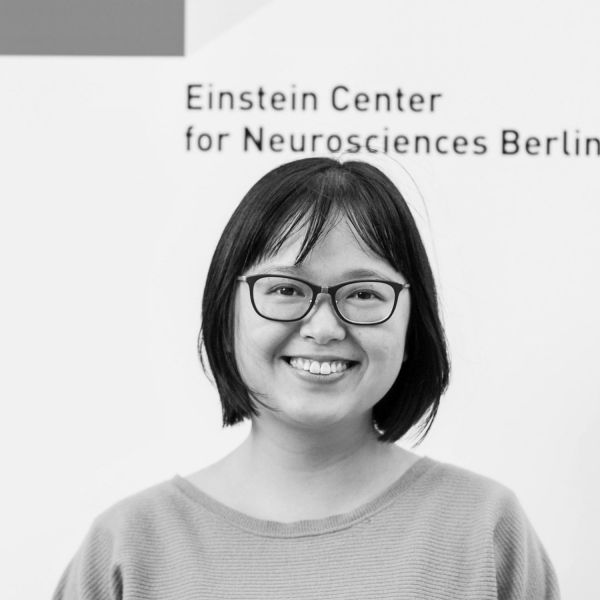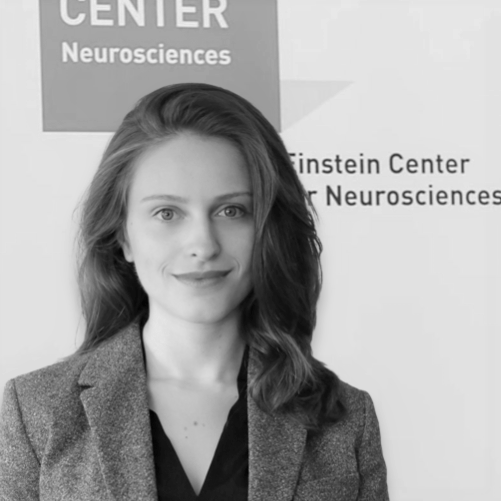Charité – Universitätsmedizin Berlin, Department of Neurology, Cognitive Neurology Lab
Contextual Modulation of Spatial Memory Consolidation
Navigation, memory consolidation, hippocampus, cognitive neuroscience, EEG, iEEG, behavior.
I would like to be a rockstar
Freie Universität Berlin, Department of Education and Psychology
Perceptual Processing During Altered States of Consciousness
Using flicker light stimulation to induce transient visual hallucinatory phenomena in healthy participants, I analyse resting state fMRI data to investigate the effects of flicker rhythmicity and frequency on thalamocortical and corticocortical dysconnectivity patterns.
Flower arranging and ashtanga yoga at oh god o’ clock (very early) are my cherished antidotes to PhD stress.
Charité - Universitätsmedizin Berlin, Department of Psychiatry and Psychotherapy
Genomic Instability in Age-Related Neurodegenerative Diseases
Genomic alterations, neurodegenerative proteinopathies, tau and TDP-43 pathology.
I like planning and I plan my day around coffee breaks.
Deutsches Zentrum für Neurodegenerative Erkrankungen (DZNE); Charité – Universitätsmedizin Berlin, Institute of Integrative Neuroanatomy
Developing high throughput screenings for screening potential synaptogenic and antisynaptogenic compounds.
I can juggle anything except my multiple research projects.
Humboldt-Universität zu Berlin, Department of Biology, Romanczuk Lab
Influence of Cognitive Biases on Collective Adaptation to Changing Environments
My research lies at the interface between computational neuroscience and complex systems science, while borrowing concepts from other fields, such as game theory and experimental psychology. I use multi-agent reinforcement learning to investigate collective adaptation to change, when individuals exhibit biased decision-making.
Although I study decision-making, I am quite bad at making decisions.
Max Delbrück Center for Molecular Medicine (MDC), Berlin Institute for Medical Systems Biology (BIMSB), Gouti Lab (Stem Cell Modeling of Development and Disease)
Modeling of Neuromuscular and Vascular Development Using Neuromuscular Organoids
Developmental biology, cellular and molecular neuroscience.
My apartment has more plants then square meters.
Humboldt-Universität zu Berlin, Institute for Theoretical Biology
Elucidating the Role of Grid Cells in Alzheimer's Disease: A Network Model of Entorhinal-Hippocampus Interactions and Pathological Disruptions
I aim to use analytical and numerical models to uncover the functional role of grid cells, and to link their dysfunction to behavioral deficits seen in medial temporal lobe pathologies such as Alzheimer’s disease.
I once taught myself to carve violin bridges, at the cost of nicking my fingers a few times. It just goes to show that violins is never the answer.
Berlin Institute of Health (BIH), Department of Computational Neurology
Parkinson’s Disease: Invasive Investigations of Connectivity-Based Biomarkers for Closed-Loop Deep Brain Stimulation
I am investigating the interaction between the cortex and basal ganglia using electrocorticography and local field potential recordings from Parkinson’s disease patients having undergone surgery for deep brain stimulation (DBS). This will inform our understanding of the mechanisms of DBS and dopaminergic agents in Parkinson’s, as well as highlight potential biomarkers for next-generation DBS treatments.
I am the proud owner of an authentic Black Watch military kilt which I never pass up the opportunity to wear. The only question is: am I a true Scotsman?
Freie Universität Berlin, Department of Education and Psychology, Neural Dynamics of Visual Cognition Group
Laminar Communication in the Human Ventral Visual Cortex During Veridical and Intrinsically-Driven Perceptual Experiences
Object perception, visual cognition, object recognition, computational neuroscience, face perception, scene perception, ultra-high field MRI.
Einstein Center for Neurosciences Berlin
I am a theoretical physicist, recently migrated to neuroscience. I am specialised in many-body physics, complex systems and emergent behaviours, and I am interested in the application of these frameworks to neural systems.
German Institute of Human Nutrition (DIFE), Department of Neuroscience of Decision and Nutrition
Disturbances in Body Image and the Role of Interoception
Body image, body ownership, interoception, virtual reality and eating disorders. The main aim of my research is to better understand body image disturbances in eating disorders and to investigate the interaction between body ownership and interoception. In my research I use virtual reality technology to investigate ways to reduce body image disturbances.
I’ve been known for badly singing Evanescence in inappropriate situations, when I don’t realize that I am unmuted.
Charité – Universitätsmedizin Berlin, Institute of Sexology and Sexual Medicine
Female Orgasmic Dysfunction
The working group Female Desire deals with the foundations of female sexuality from a biopsychosocial perspective. We aim to promote women's sexual health by working on the development of new diagnostic, therapeutic and preventive approaches.
Trying to come up with an answer for prompts like this always induces an existential crisis for me.
Charité – Universitätsmedizin Berlin, Department of Neurosurgery, Image Guidance Lab
Preconditioning of the Motor Network With Repetitive Transcranial Magnetic Stimulation to Reduce the Mortality Risk in Neurosurgery
Noninvasive brain stimulation, repetitive transcranial magnetic stimulation (rTMS), clinical neuroscience, glioma, motor system, plasticity, reorganization.
My “second PhD project” is improving the anatomic accuracy of the brain cakes I bake.
Charité - Universitätsmedizin Berlin, Department of Neurology,
rTMS for Enhancing Brain Computer Interface-Induced Plasticity in Stroke: A Crossover Design
Clinical neuroscience, brain stimulation, brain-computer interface, EEG, MRI.
After studying motor function, I go to dance lessons to learn something new.
Max Planck Institute for Human Cognitive and Brain Sciences, Neurology Department, Somatosensory Group
Somatosensation, Perception and Decision Making With a Focus on Subliminal Stimuli and Metacognition
Clinical psychology and neurology, computational neuroscience, psychophysics.
Yoga teacher and climbing addict like every other person in Berlin/Neukölln.
Charité - Universitätsmedizin Berlin, Department of Psychiatry and Psychotherapy, AG Learning and Cognition
Neurobiological and Behavioral Substrates of Decision Making Under Uncertainty in the Context of (Subclinical) Psychosis
Computational psychiatry, decision making, reinforcement learning.
Neuroscience is no fun (No Fun et al. , 2020). But I have a scientific publishing joke, please purchase PDF for $39 for 24h access or $70 for full access.
Charité – Universitätsmedizin Berlin, Department of Exprimental Neurology
Spinal Cord Stimulation for Motor Restoration in Parkinson’s
I am establishing a closed-loop stimulation paradigm for amelioration of Parkinson’s symptoms. Moreover I am developing few software pipelines for analyzing neural and kinematics data.
I built a glitter bomb embedded in a toy-dog; I like to sketch small drawings of funny things people say.
Freie Universität Berlin, Department of Education and Psychology, Neural Dynamics of Visual Cognition Group
Computational Modeling of Vision-Related Neuroimaging Data
Computational cognitive visual neuroscience, M/EEG, fMRI, deep learning, human visual object recognition.
Not sure it is fun, but I’m into playing Frisbee, arthouse movies and mountains.
Max Planck Institute for Human Cognitive and Brain Sciences, Department of Neuropsychology
Voice–Speech Interactions in Infant Phoneme Acquisition
Developmental cognitive neuroscience, early language acquisition, phoneme acquisition and voice processing in infancy. In my PhD project, I investigate how infants learn the vowels and consonants of their native language, and how this learning process interacts with the processing of the voices of the speakers the infants are listening to.
Humboldt-Universität zu Berlin, Plested Lab
Electrophysiological Investigation of Ampa Receptor Auxiliary Proteins
TARPs (Transmembrane AMPAR Regulatory Proteins) are a family of auxiliary proteins which modulate many aspects of AMPA receptor physiology. I use patch-clamp recording to examine how they alter ion channel pharmacology and are regulated by phosphorylation.
Breakfast is the least important meal of the day.
Charité - Universitätsmedizin Berlin, Department of Pediatrics with a focus on Neurology, AG Schülke Group
Thra Deficiency and Allan-Herndon-Dudley-Syndrome: Defects of Local Thyroid Hormone Function During Human Brain Development
The main goal of the PhD project is to characterize, by means of molecular and bioinformatic tools, the epigenomic landscape that regulates the timely and spatial expression and splicing of SLC16A2 and THRA, the 2 main genes involved in the developmental diseases Allan Herndon Dudley Syndrome (AHDS) and Thyroid Hormone Receptor Alpha deficiency (THRA-deficiency) respectively.
When I´m not hopping around the lab, I´m doing artistic gymnastics. Also, my favorite dish is pasta (yes, I am Italian indeed).
Freie Universität Berlin, Department of Education and Psychology, Neural Dynamics of Visual Cognition Group
How Does Each of the Core Regions Active During Vision Represent Objects?
Cognitive neuroscience, vision, fMRI, DNNs, object representations, ventral visual stream.
Charité - Universitätsmedizin Berlin, Institute of Medical Psychology
My research will center on the relationship between childhood maltreatment, diurnal cortisol patterns in pregnancy, and immune cell profiles in mid-gestation with a focus on how these combined factors contribute to the intergenerational transmission of childhood maltreatment.
I keep a spreadsheet of all the concerts I’ve ever been to. I brew my own kombucha. I used to compete on a snowboard racing team.
Charité - Universitätsmedizin Berlin, Department of Experimental Neurology
Human Schwann Cell Myelinated Sensory and Motor Neuron Co-cultures as Disease Models of Inflammatory Demyelinating Polyneuropathies
I work with induced pluripotent stem cells (iPSCs) and we differentiate them into peripheral sensory neurons (iPSC-DSN) to model chemotherapy-induced polyneuropathy. Expanding on this model, we will differentiate iPSCs to Schwann cells and to motor neurons, to study inflammatory demyelinating polyneuropathies (IDP) such as chronic IDP, Guillain-Barré syndrome, immune checkpoint inhibitor-related neuropathies and paraneoplastic neuropathies.
I like pandas!
Humboldt-Universität zu Berlin, Larkum Lab
Towards the Definition of an Optimal Convergent Deep Brain Stimulation Circuit Target for Individual Non-Motor Symptom Constellations in Parkinson’s Disease
My scientific interests include symptom-specific connectomic deep brain stimulation (DBS) for the therapy of neurological and psychiatric circuitopathies, patient-centered precision neuromodulation, optimal DBS target modeling, and transdiagnostic / dimensional approaches in neuropsychiatry.
If you were to draw a Venn diagram of former unicycle club members and people who happen to be good at assembling IKEA furniture, you would find me in its slim center.
Technische Universität Berlin, Sprekeler Lab
Perceptual Decision Making with a Continuum of Alternatives
Theoretical neuroscience, statistical analysis of neural data, plasticity, inhibition
I think we should ‘solve the worm first’ before trying to understand the human brain.
Charité – Universitätsmedizin Berlin, Department of Experimental Neurology
Fate Mapping of Myeloid Cell Subsets Following Ischemic Stroke
Neuroimmunology and inflammation in animal models of ischemic stroke. Specifically, the involvement of microglia and monocyte-derived macrophages in the pathophysiology of stroke injury.
Although I think I am usually funny, I could not find one fun fact about myself!
Charité - Universitätsmedizin Berlin, Department of Psychiatry and Neurosciences, Division of Translation and Neurotechnology
Assessment of Digital Health Literacy and Digital Health Service Utilization Among People Diagnosed With Bipolar Disorder in Germany
Digital psychiatry, how do people diagnosed with bipolar disorder interact with/within the ever-evolving realm of digital health?
I have lived in a town that is exactly on the equator at 0° & love talking longitudes and latitudes, plus everything Geography.
Charité – Universitätsmedizin Berlin, Department of Computational Neurology
Monitoring and predicting brain states in unresponsive patients with machine learning-based approaches in the ICU
Computational neuroscience, consciousness, machine learning, translational, EEG.
Charité-Universitatmedizin Berlin, Institute of Cell Biology and Neurobiology, AG Lehnardt
A Role Beyond Gene Regulation: How Extracellular miRNAs Affect Neuronal Structure and Function
Neuroimmunology, toll-like receptors, neurodegeneration.
I tinker with electronics in my spare time.
Charité – Universitätsmedizin Berlin, Shoichet Lab
I am working on Syngap1 mutation using cerebral organoids as a model. I work in the field of molecular/cellular neuroscience.
I usually read many different books at the same time
Technische Universität Berlin, Sprekeler Lab
Learning of Intelligent Swarm Behaviour
Deep reinforcement learning, cognitive neuroscience, animal psychology
I used to do freestyle wrestling in the state team of North Rhine-Westphalia before deciding to play Magic: The Gathering semi-professionally
Humboldt-Universität zu Berlin, Institute of Biology, Bernstein Center for Computational Neuroscience Berlin
I am applying methods from computational psychiatry to understand the neural mechanisms of hallucinations induced by serotonergic psychedelics.
I’m fascinated by plant biochemistry and am working on a database detailing the pharmacology of compounds from more than 400 herbs.
Charité – Universitätsmedizin Berlin, Clinic for Neurology with Experimental Neurology
Modeling Chemotherapy-Induced Neuropathies in iPSC-Derived Sensory Neurons
My fields of research are experimental neurology, neurotoxicology, stem cell research and the peripheral nervous system. I investigate the molecular signaling cascades of sensory neurons in response to chemotherapeutic treatment and am eager to elucidate novel potential therapeutic targets for this burdensome disease.
Among my favorite hobbies are oversharing of personal information and very optimistic time planning. My colleges know minutes before I enter the office I’m there since my high-pitched laugh is audible as soon as I arrive on campus.
Humboldt-Universität zu Berlin, Faculty of Life Sciences, Institute for Theoretical Biology
An Investigation of the Effects of Principal-Cell Heterogeneity in Network Models of SPW-Rs
The rhythms of the brain often emerge from timely interactions between functionally and morphologically distinct neural populations. These interactions can be described by mathematical models and understood through the theory of dynamical systems. In my research, I extend classic models of Sharp Wave-Ripples to include recent and ongoing discoveries on cell-type heterogeneity and study their effects on the network dynamics. These waves originate in the hippocampus and are crucial for memory consolidation.
I have a name in Esperanto (Garlando), I like to write poems for important occasions, and, when I make friends from different countries, I try to learn a bit of their language and to cook some dishes from their cuisine.
Charité - Universitätsmedizin Berlin, Centre for Stroke Research, Experimental Neurology
Post Stroke Pial Collateral Remodeling and Neuronal Plasticity in Motor Recovery
Collateral circulation refers to the cerebral blood flow of artery-to-artery anastomotic vessels that may act as endogenous circumventers during large vessel occlusion. Collateral remodeling is a major determining factor of stroke outcome as patients with good collateral circulation have better prognoses and benefit greatly from reperfusion. Factors that give rise to differences in individual collateral circulatory systems are not well understood, nor is the correlation between post-stroke collateral remodeling and post-stroke neural rewiring. Therefore, this project aims to answer the questions: how and why does collateral remodeling differ so vastly between individuals, and how are these differences linked to functional readouts.
I was named after my mum’s favourite tennis star, but now people tend to notice more the similarities I share with the author of Twilight.
Charité - Universitätsmedizin Berlin, Institute of Cell and Neurobiology, Neurodegeneration and Neuroimmunology Research Group
Understanding microRNAs as Signalling Molecules and Modulators of Neurodegeneration
I am researching the role of microRNAs within the context of neurodegeneration, particularly in Alzheimer’s disease. These molecules may be novel regulators of inflammatory processes in the disease and provide the opportunity for therapeutic and biomarker discovery for Alzheimer’s.
Charité - Universitätsmedizin Berlin, Neuroscience Research Center and NeuroCure Cluster of Excellence, AG Schmitz
Homeostatic Plasticity in Cortical Human Pyramidal Neurons
Multipatch electrophysiology, targeted repatching, some coding.
Charité - Universitätsmedizin Berlin, Department of Neurology and Experimental Neurology
Investigating Periodic and Aperiodic Cortico-Subthalamic Coupling With Time-Resolved Spectral Parametrization in Patients With Parkinson’s Disease
Parkinson’s disease is a neurodegenerative disorder, with the loss of dopaminergic neurons in the basal ganglia being one of the main pathologies of the disease. Deep brain stimulation of the subthalamic nucleus had revealed pathological synchronization of the neural activity in the basal ganglia, within the frequency range of 8-35 Hz. However, both, the mechanism of the this synchronization remains unknown. My research focuses on investigating these fundamental mechanisms through time-resolved spectral parametrization of the brain activity and the resulting couplings of the periodic and aperiodic spectral features.
Not sure if it’s fun, but I used to run a one-person vegan-bakery business during my Master's.
Max Planck Institute for Human Development, Max Planck UCL Centre for Computational Psychiatry and Ageing Research, Research Group NeuroCode
Representation and Distortions in Cognitive Maps of Task States
Value-based decision making and task representation in the brain; human fMRI and multivariate analysis methods.
On an ongoing search for non-scientific hobbies, suggestions are welcome!
Charité - Universitätsmedizin Berlin, Department of Psychiatry and Neurosciences, Research Group Learning and Cognition
Reward Processing and Reinforcement Learning in Alcohol Use Disorder and Major Depression
My research falls into the field of computational psychiatry: I aim to capture reward learning and decision making in psychiatric disorders by means of computational parameters and to link them to their neurobiological correlates.
Staying up late or getting enough sleep – struggle of my life.
Charité - Universitätsmedizin Berlin, Institute of Medical Psychology
Maternal Cortisol Concentrations During Pregnancy and Infant White Matter Microstructure
Diffusion tensor imaging, human brain development, stress.
I have a kombucha factory in my kitchen. Just ask me if you’d like some. I’d be very happy to free up some space.
Humboldt-Universität zu Berlin, Department of German Language and Linguistics
Interaction of Linguistic and Non-linguistic Context in Language Processing
The main aim is to investigate the interaction between world knowledge and temporal verb morphology in language processing. A secondary aim is to investigate this effect in non-native speakers of diverse linguistic backgrounds to determine how the grammar of a native language can affect the on-line processing of a second language when multiple sources of information are involved.
Charité - Universitätsmedizin Berlin, International Graduate Program Medical Neurosciences
My main interests lie in the neurobiology of consciousness and thought, which I plan to investigate in humans and rodents. I intend to approach consciousness from an experimental structuralist standpoint, behaviorally assessing the qualia space in different sensory modalities and using it as a map to find the neural mechanisms behind consciousness.
You need to use your nose to pronounce my name properly.
Charité - Universitätsmedizin Berlin, Institute of Cell Biology and Neurobiology
Molecular Determinants of Neocortical Development
We are interested in identifying the mechanisms that regulate the normal timing, extent and final maturation of the dendritic tree during formation of the mammalian neocortex. Furthermore, we also investigate how defects in these mechanisms contribute to the development of neurodevelopmental disorders.
In my free time I really like to swim, and I once swan across a 1 km fjord for fun.
Max Planck Institute for Human Development
Representational Dynamics During Working Memory in Schizophrenia
Application of dynamical systems theory and state space mappings to representational dynamics in working memory. In particular how these help us understand the cognitive deficits underpinning Schizophrenia.
Humboldt-Universität zu Berlin, Faculty of Life Sciences, RG Optobiology
Unveiling Axonal Maturation and Unconventional Roles of Lysosomes and Autophagosomes; Understanding the Mechanism of Microtubule Acetylation
My research is focused on the autophagosomal-lysosomal system and unconventional roles of these organelles like exocytosis. Specialized culturing vessels called microfluidic devices are used to separate and study neuronal compartments by live-cell imaging, immunocytochemistry, mass spectrometry and biochemical methods. I am also investigating the microtubule post-translational modification acetylation and the mechanism of the acetylating enzyme αTAT1 to recognize and enter the microtubule lumen.
I grew up on a small island.
German Center for Neurodegenerative Diseases (DZNE), Synaptopathy
Role of Pre-synaptic Autophagy in Clearance of Pathogenic Alpha-Synuclein Aggregates and Neuroimmune Response Modulation in Alzheimer’s Disease
Neurodegeneration, Alzheimer’s disease, Parkinson’s disease, microglia, autophagy, alpha-synuclein, neuroinflammation.
I did not know what my name really meant until I came to Berlin.
German Institute of Human Nutrition (DIfE), Department of Decision Neuroscience and Nutrition
Circadian Rhythms, Mealtime and Their Influence on Decision-Making
My research investigates circadian rhythms and human decision-making. Specifically, I am interested in the relationship between food intake, circadian rhythms and cognition.
Charité - Universitätsmedizin Berlin, Network Stimulation Laboratory (NetStim)
Unraveling Diseases of the Human Connectome Through Deep Brain Stimulation
Connectomics, deep brain stimulation, fiber filtering, movement disorders, Tourette’s syndrome.
I once had to spend 8 hours alone without phone connection in the middle of a mountain range in winter
Charité - Universitätsmedizin Berlin, Department of Psychiatry and Psychotherapy
Predicting Psychiatric Disorders Using Machine Learning and Normative Modelling
Computational psychiatry, MRI, machine learning.
I live in an endless loop of re-learning and forgetting mathematical notations and performance metrics.
Humboldt-Universität zu Berlin, Department of Psychology, Neurocognitive Psychology
Why Not Only the Nose Is Getting Longer: Behavioral and Neurocognitive Investigations on Speech Production During Lying
Language, speech production, social interaction, emotion perception, EEG, cognitive neuroscience.
I used to speak Nicaraguan sign language.
Charité – Universitätsmedizin Berlin, Department of Neurology with Experimental Neurology, Brain Stimulation Section
How the Brain Creates Beliefs - Brain Simulation Approach
I am interested in high-order cognitive functions and general theories explaining cognition such as hierarchical predictive processing.
Re-learning math when you are a graduate student hurts, a lot.
Leibniz-Forschungsinstitut für Molekulare Pharmakologie (FMP), Research Group Synapse Biology
Elucidating the Nanoarchitecture of the Presynaptic Proteome
Molecular mechanisms of synaptic transmission, proximity labeling, presynaptic functions.
I am a part-time linguist and German teacher.
Charité - Universitätsmedizin Berlin, Department of Psychiatry and Neurosciences, Research Group Recreational Drugs
Psychedelic Drugs for the Treatment of Substance-Use Disorder
Classic hallucinogens, atypical hallucinogens, psychiatric disorders, clinical neuroscience, meta-analysis, questionnaire.
I come from the most isolated city in the world (Perth). I've been asked by multiple neuroscientists if my twin brother and I are identical :')
Humboldt-Universität zu Berlin, Institute of Biology, Bernstein Center for Computational Neuroscience Berlin
The functional role of prefrontal cortex serotonin for value-based decision-making and time valuation on a behavioral and neural level in rats
Applying computational models to understand intelligent decision-making on a behavioral systems and a neurophysiological circuit level in animals. Incorporate dopamine and serotonin sensors to elucidate the role of these neuromodulators in decision-making, as well as their contribution to related behavior in models of psychiatric conditions.
I collect swords and hang them up in my apartment.
Humboldt-Universität zu Berlin, Larkum Lab
Psychedelics and Neuronal Circuits
I am interested in neuronal and circuit mechanisms underlying psychedelic actions with a particular emphasis on dendro-somatic processing in cortical layer 5b pyramidal neurons and the circuit involving layer 6b and higher-order thalamus.
Charité – Universitätsmedizin Berlin, Department of Neurology, Cognitive Neurology Lab Berlin
Auto-Immune Driven Progressive CNS Atrophy in Anti-IgLON5 Disease: From Genetics to Neurodegeneration
Brain atrophy, MRI, HLA-conferred risk, mechanisms of autoimmunity.
A crocodile was once named after me.

